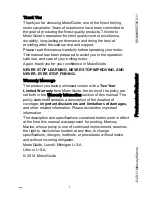
4
“SKY UB1”
- select the user band slot number for SKY SCR standard on output 1 of multiswich. When slot number is set to “OFF” - corresponding
user band will be not accessible on output 1 of multiswitch. This number can be in range 1 - 32.
“SKY UB2”
- select the user band slot number for SKY SCR standard on output 2 of multiswich. When slot number is set to “OFF” - corresponding
user band will be not accessible on output 2 of multiswitch. This number can be in range 1 - 32.
6.2.3
Test tone type
Enabled columns in the
“TEST TONE“
type:
“Output frequency, MHz
” - enter output frequency of generated test tone in range of 950 - 2150 MHz;
“Output”
- select multiswitch output in which the test tone will be generated.
6.3
Structure window
It is possible connect (chain) the outputs of multiple switches together with RF combiners and setup each of the switches to provide the signal from
a different satellite position.
For example you can configure one switch for satellite A and a second one for satellite B. If the receiver now requests a channel from satellite A
the first switch will enable the user band while the seconds switch will disable the user band. If the receiver requests a channel from satellite B, the
first switch will deactivate the user band and the seconds switch will provide the user band. In static mode only one user band with same output
frequency of connected multiswitches will be active, depending of selected satellite position.
The structure window is accessed after selection of “Structure” line in the main menu. In this window (Figure 4) whole structure of chained
multiswitches is described.
Figure 4. Structure window
The upper line of controls in the structure window is the same, as in the “Main window” (see section 6.1).
Before making any changes in the structure window, select correct model of the connected multiswitch in the “DSCR model” table. The next step
is assignment of satellite positions to chained multiswitches.
1. Connect only one multiswitch for satellite A to programmer.
2. Select satellite A option in the “Configuration” table.
3. Press “Set” button in the “Configuration” table.
4. Repeat 1-3 steps for remaining chained multiswitches.
Now all chained multiswitches are set to different satellite positions. Connect all chained multiswitches to programmer. Select correct count of total
satellites, LNB parameters in the “Input parameters” table. Press “Save” button. Press “Set” button to send configuration to all chained multiswitches.
When only one multiswitch is connected to output network, select correct model of the connected multiswitch in the “DSCR model” table, set count
of total satellites to one and LNB parameters in the “Input parameters” table. Press “Save” button.
Note
: contents of “Configuration” and “Input parameters” tables depends of capabilities of selected DSCR model.
6.4
Settings window
The settings window is accessed after selection of “Settings” line in the main menu. In this window (Figure 5) output power and Wi-Fi settings are
described.
Figure 5. Settings window
The “DSCR power” line in “Device parameters” table used to switch on/off DC power voltage to the multiswitch from programmer. When the “DSCR
power” is set to “ENABLED” - DC power voltage and 22 kHz commands from programmer is connected to RF input connector [2] (see section 3),
DC power and 22 kHz commands from RF output connector [3] (see section 3) are disconnected. When the “DSCR power” is set to “DISABLED”-
DC power voltage from programmer is disconnected from RF input connector [2], DC power and 22 kHz commands from RF output [3] are passed
thru to connector [2] (see section 3).
The programmer can work as Wi-Fi access point and allow to connect other devices or connect to other access point in “Client” mode.
Wi-Fi settings in the “Access point” mode shown in Figure 5 above.
Note
: in the “Access point” programmer supports only one connection and Wired Equivalent Privacy (WEP) security standard.
Description of the “IP parameters” table lines in “Access point“ mode.
A service set identifier (SSID) is a sequence of characters that uniquely names a wireless local area network. It is a text string up to 32 characters
length.
























